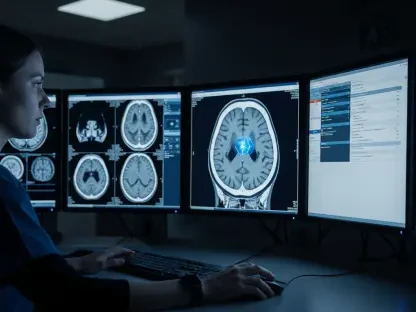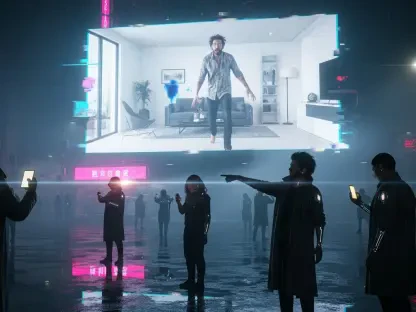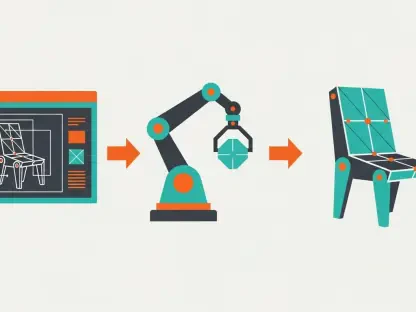In an era where digital landscapes evolve at breakneck speed, Artificial Intelligence (AI) has emerged as a game-changer for creative industries, particularly in advertising and content creation, redefining how campaigns are conceptualized, developed, and delivered. This technology is no longer a distant dream but a tangible force that streamlines processes which once demanded significant time and resources, allowing brands to stay agile in a competitive market. From drafting compelling ad copy to generating eye-catching visuals, AI is enhancing human creativity with data-driven precision. Small businesses and large enterprises alike now have access to tools that democratize sophisticated design and messaging capabilities, breaking down barriers that once limited innovation. As AI continues to integrate into workflows, it challenges traditional methods, pushing the boundaries of what’s possible in storytelling and audience engagement across multiple platforms.
Revolutionizing Traditional Advertising Models
AI is fundamentally altering the landscape of advertising by dismantling outdated, inefficient workflows that have long plagued the industry. Historically, the creation of a single campaign often involved disjointed teams handling copywriting, graphic design, and media planning, resulting in frequent miscommunication and extended timelines. Today, AI-powered platforms bring these elements into a unified system, enabling simultaneous development of text and imagery. This integration slashes production costs and minimizes the need for endless revisions, all while upholding high standards of quality. Brands can now pivot quickly without sacrificing consistency, ensuring that their messaging remains sharp and effective across diverse channels. The ability to streamline such complex processes marks a significant departure from the past, offering a glimpse into a future where efficiency and creativity coexist seamlessly in the advertising realm.
Beyond integration, the sheer speed that AI introduces to creative production is nothing short of transformative. Tasks that previously spanned weeks, such as drafting multiple iterations of a campaign or tailoring content for various social media platforms, are now completed in a matter of minutes. This rapid turnaround empowers brands to capitalize on emerging trends or respond to audience reactions with unprecedented agility. Marketing teams can test ideas in real time, adapting strategies on the fly to align with consumer sentiment. Such responsiveness not only enhances campaign relevance but also builds stronger connections with target demographics. Moreover, this accelerated pace does not come at the expense of depth or thoughtfulness; instead, it allows for more strategic focus on crafting impactful narratives that resonate. As a result, AI’s role in hastening creative output is redefining the very tempo of modern advertising, setting a new standard for efficiency.
Enhancing Personalization and Scalability
One of the most remarkable advantages of AI in creative workflows lies in its capacity to deliver highly personalized content tailored to specific audience segments. By leveraging vast amounts of data, AI tools analyze consumer behavior and preferences to create messages and visuals that feel uniquely relevant to each viewer. This level of customization ensures that campaigns cut through the noise of generic advertising, fostering deeper engagement and loyalty among consumers. Whether it’s adjusting tone for a younger demographic or curating imagery that reflects cultural nuances, AI enables brands to speak directly to individuals rather than broad, faceless crowds. This precision in targeting transforms how content is perceived, making interactions with brands more meaningful and effective in driving desired actions.
Equally significant is AI’s ability to facilitate scalability in content creation, a feature that was once prohibitively expensive for many organizations. With these advanced tools, creators can produce countless variations of a campaign to test different approaches without straining budgets or manpower. This experimentation is further enhanced by real-time analytics, which provide immediate insights into performance metrics, allowing for continuous refinement of content. Campaigns can be optimized on the go, ensuring maximum impact and return on investment. Such scalability empowers even smaller brands to compete with industry giants, as access to these capabilities no longer requires vast resources. By combining personalization with the ability to scale effortlessly, AI is leveling the playing field, enabling a broader range of creators to innovate and succeed in crowded digital spaces.
Unifying Copy and Design for Cohesive Campaigns
AI is bridging the longstanding divide between copywriting and visual design, creating a harmonious workflow that elevates the quality of creative output. In traditional settings, these two elements were often developed in isolation, leading to inconsistencies in tone and branding. Now, AI platforms enable simultaneous crafting of text and imagery, ensuring that every piece of content aligns perfectly with a brand’s identity. This synergy produces campaigns that not only look polished but also strike an emotional chord with audiences through unified storytelling. The seamless interplay between words and visuals amplifies the overall impact, making advertisements more memorable and persuasive. As a result, brands can establish a stronger presence in the minds of consumers, building trust through consistency and clarity in their messaging.
This unified approach also brings a notable boost in efficiency, allowing creative teams to focus on strategy rather than repetitive tasks. AI handles mundane aspects like formatting or generating initial drafts, freeing up professionals to concentrate on refining concepts and exploring bold ideas. By offering intelligent suggestions for both copy and design, these tools act as collaborators, enhancing the creative process without overshadowing human input. The balance struck between automation and artistry ensures that output remains authentic while benefiting from technological precision. This dynamic is reshaping marketing practices, proving that technology can amplify rather than replace the human touch. As AI continues to evolve, its role in integrating these critical components of advertising will likely deepen, setting new benchmarks for what cohesive, impactful campaigns can achieve.
Looking Ahead to an AI-Driven Creative Future
Reflecting on the strides made, it’s evident that AI has reshaped creative workflows by tackling inefficiencies and fostering integration across advertising processes. The journey saw fragmented systems give way to streamlined platforms where speed, personalization, and cohesion became the norm. Campaigns that once took weeks to develop were condensed into days or even hours, while tailored content reached audiences with pinpoint accuracy. Real-time analytics further refined these efforts, ensuring every piece of content performed at its best. This evolution marked a turning point for brands, enabling both small players and industry leaders to harness cutting-edge tools that redefined engagement.
Moving forward, the focus should shift to embracing deeper AI integration across diverse media formats like video and audio, while exploring hyper-personalization to connect with audiences on an even more granular level. Creative professionals are encouraged to adopt AI-first strategies, building entire workflows around these capabilities to stay competitive. Experimenting with emerging tools and staying attuned to data-driven insights will be key steps in navigating this landscape. As the industry continues to transform, collaboration between human creativity and AI innovation promises to unlock untapped potential, paving the way for groundbreaking storytelling in advertising and beyond.









